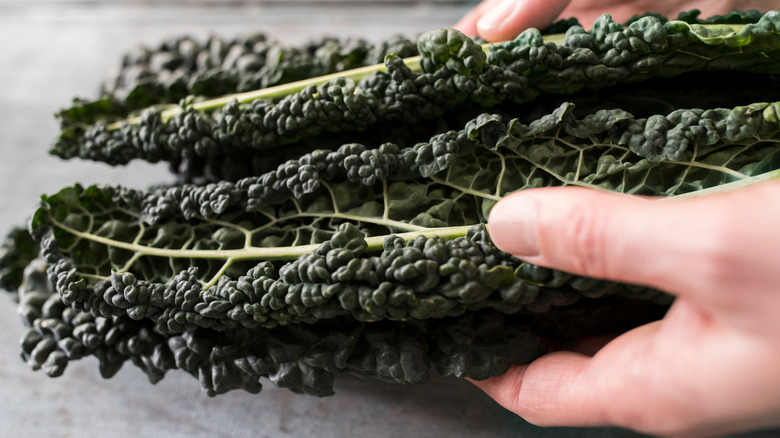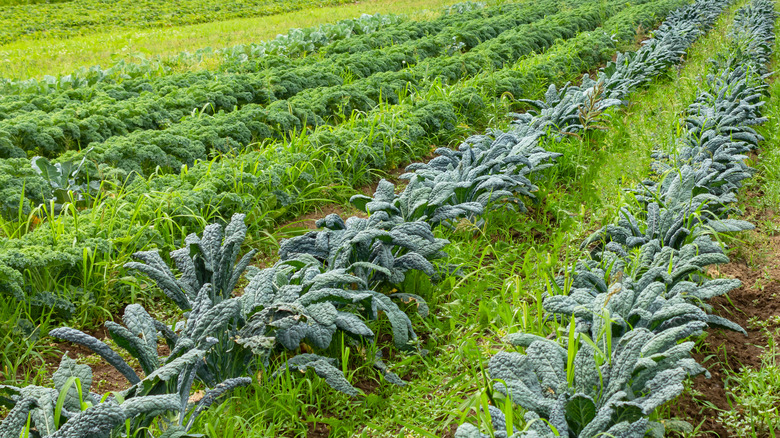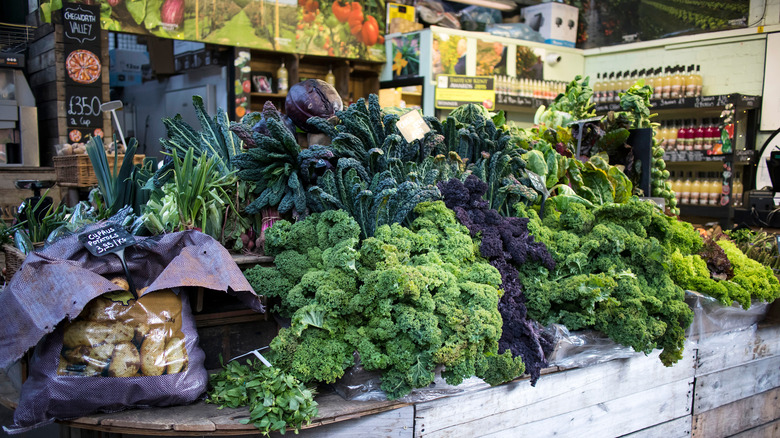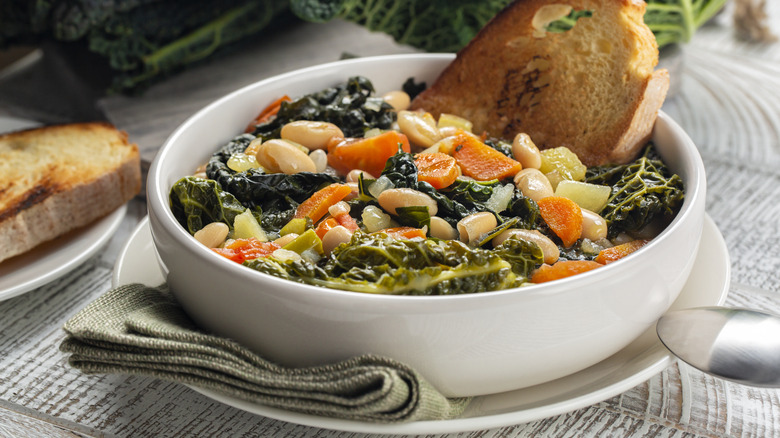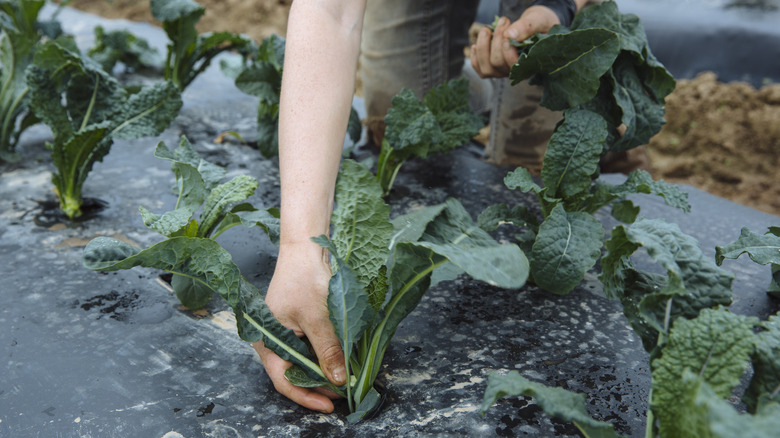What Makes Dinosaur Kale Unique
Kale is by no means a new vegetable. It isn't a hybrid created by farmers or agricultural scientists. According to the Wisconsin Department of Public Instruction, kale has been around for about 2,000 years, but one could easily believe it was brought into existence less than 20 years ago the way it exploded in popularity between 2007 and 2012, per Bloomberg. Around this time, Americans could not get enough kale in their smoothies, salads, and grain bowls. If you thought its rise to fame was due to people simply realizing how nutritious this leafy green vegetable was, think again. This spike in was actually due to a very intentional and brilliant PR campaign.
According to Self, the American Kale Association hired rockstar PR rep Oberon Sinclair to develop a high-profile campaign around the vegetable that was mainly used as a garnish. It didn't take long for Sinclair's high-profile contacts in fashion, cuisine, and media to help launch kale into superstar status. Today people are probably most familiar with curly kale, the stalky, green veggie with leaves that bunch up and curl like a new perm, because it's the varietal most found in supermarkets. But there are several types of kale that vary in size and color. If you ever stumble across dinosaur kale on your shopping ventures, take some home to experience a delicious, healthy, and unique vegetable that (as Sinclair intended) might become a culinary staple.
What is dinosaur kale?
Native to Italy, dinosaur kale also goes by the names cavolo nero, Tuscan kale, Lacinato kale, and black kale, per The Spruce Eats. Its leaves are wrinkled and bumpy, giving them the appearance of reptile skin, which explains why its name honors the prehistoric creatures. Like other types of kale, it is a member of the cabbage family, along with brussels sprouts, cauliflower, and broccoli, per the Los Angeles Times. Dinosaur kale has long leaves, usually up to three feet in length, and is so dark in color that some describe it as having a blue or black hue, according to The Spruce Eats. Despite its severe appearance, dinosaur kale is actually fairly mild in flavor — expect notes of broccoli or cabbage, with a pleasant nuttiness and earthy richness.
All kale is a nutritional powerhouse. Not only does one cup include a full day's worth of vitamins A, C, and K, it also contains calcium, potassium, and manganese, is high in free radical-fighting antioxidants, and has been shown to help lower cholesterol. The Mayo Clinic points out that a single serving has 33 calories and 7 grams of carbs and is a particularly good option for those who have diabetes or are watching their calorie intake.
How is dinosaur kale different?
Curly kale is the kale varietal that is most commonly found in grocery stores, but you may have also seen several other types at farmer's markets or gourmet food shops. Curly kale has tight, ruffly leaves. When eaten raw, the leaves are much tougher than lettuce leaves, unless you've purchased baby kale, in which case the leaves are considerably smaller and very tender, per The Tasty Tip. Curly kale can taste pungent and a little bitter, but the flavor tends to mellow when cooked. According to The Mayo Clinic says Redbor kale can have gorgeous red or purple curly leaves, and Russian kale has flatter, spiky green leaves that grow on a purple stem. Some kale varietals are meant to be showcased, not eaten, and are known as ornamental varieties. They come in an array of colors and look smashing in gardens and floral displays.
Dinosaur kale is strikingly different from other kale types. Between its dark color, long leaves, and unique texture, it is not easily mistaken for curly or any other kale. The flavor is also quite different from the popular curly. Whereas curly can be peppery and robust, dinosaur kale has a mild, soft flavor whether eaten raw or cooked. The Spruce Eats suggests that it might appeal to those who don't enjoy other types of kale because of its sweeter flavor.
The best way to eat dinosaur kale
Because of its mild, pleasant flavor, dinosaur kale really doesn't need to be cooked at all to be enjoyed. The stems, or ribs, are pretty thick, so it's probably best to discard those and just use the leaves if you're using it raw. Of course, be sure to wash the leaves and ensure there is no dirt on them. You can add the chopped leaves to salad, blend it into smoothies, and turn it into a unique pesto sauce. The Spruce Eats suggests eating fresh kale within a week of purchasing it and storing it in the refrigerator. You can also freeze it for up to a year if you cut out the ribs and blanch it first.
The long leaves of dinosaur kale make it ideal for making crispy, salty kale chips in the oven per Bon Appétit. It is also ideal an ideal green to include in soups, especially the Tuscan specialty chicken ribollita, which traditionally uses dinosaur kale. For something easy and delicious, sauté the leaves in olive oil and garlic and serve as a side dish. Despite its soft texture, dinosaur kale holds up surprisingly well when it's boiled or braised for long periods of time. The Spruce Eats also recommends using dinosaur kale leaves as wrappers. Think cabbage rolls stuffed with meat and rice but using kale leaves instead.
Where you can get dinosaur kale
There are many locations that can grow dinosaur kale year round, but The Spruce Eats notes that you're more likely to find this type of kale from November through the spring when the vegetable is ripe and at its peak, and this is when its flavor is going to be its best since it is considered a winter time vegetable. This said, not every supermarket will carry it, so check out local farmer's markets and stores with a diverse produce selection.
Of course, if this is a vegetable that is not easy to find, you could always tackle growing it on your own, which isn't difficult to do. The Tasty Tip says that it is meant to withstand cold and even snow, so planting it in the fall is perfectly fine. Many online seed retailers offer dinosaur kale seeds, and you can either start the seed indoors and grow seedlings before transplanting them outdoors or just sow the seeds directly in your garden, according to Gardener's Path. The website notes that the plant will be ready for harvesting baby kale in about 30 days, and larger leaves in 60-80 days. At whatever stage you choose to harvest, you'll be treated to a delicious, versatile, and very nutritious green.
